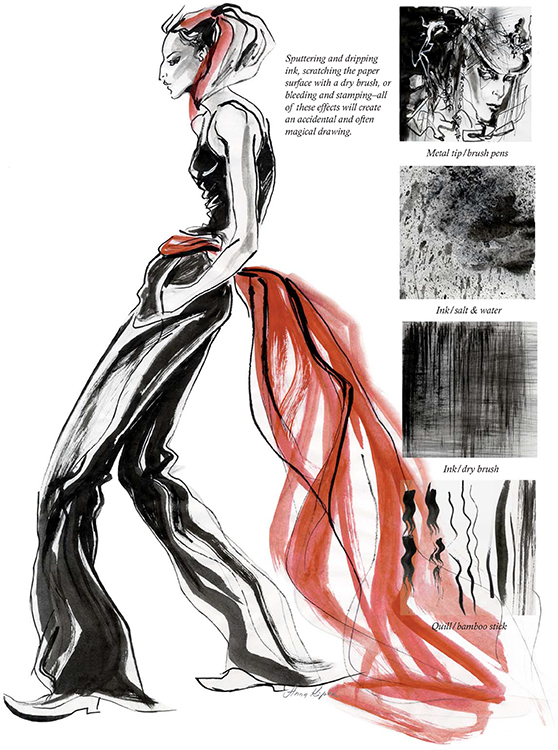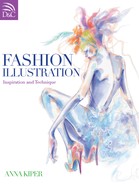EXPLORING MEDIA

INK
A large spectrum of supplies and materials are available to enhance a variety of illustration techniques and styles. Coloured media is exciting and expressive, but most artwork begins with a pencil or ink line drawing.
Ink is spontaneous and perfect for linear or dimensional wash illustrations. India ink applied to paper with a brush, reed pen, or a fine point nib can create an unpredictable variety of lines. Loose, spiky, broken, bold, faded, and irregular lines merge into an energetic drawing. This is called “line quality.”

PENCIL
Line drawing is pure, simple, and expressive. Graphite, charcoal, or china markers are appropriate for quick and loose line drawing. When detailed work is needed, classic HB pencils are preferred for their fine, flexible lines. To achieve dramatic line quality, apply varying pressure and hand movements.

Cross-hatching and smudging are ideal for shading, which can vary from soft to intense. Erasers can be used to create highlights when gently applied over shaded areas.

COLOURED PENCILS
Coloured pencils mixed with other media or used by themselves can create spectacular textures. The wide range of line qualities can be used to gradually add layers of depth, dimension, and a variety of surfaces.

Pastels and paints applied with a dry brush, and even eye make-up, will blend organically with coloured pencils on craft paper.
Pencils can be applied over tinted or coloured papers for a partial, looser rendering effect that exposes the background colour. Often the background is used as the model’s skin-tone.

MARKERS & PENS
Markers come in a variety of brands and colours. More shades can be obtained by layering and blending. A variety of tips, sometimes up to three in one marker–from fine point to wide wedge and brush–will allow an artist to create a spectrum of lines and strokes.

Compared to ink, gouache, and pencils, markers are a smooth and vibrant media. Markers work best on specifically designed marker paper. Unusual experimental effects are achieved when they are used on translucent or rough surfaces. When applied evenly in layers, markers can look as flat and opaque as gouache. When applied partially from the back and front of paper, and blended with a special blender marker or alcohol, markers can imitate the transparency of watercolour.

WATERCOLOUR
Transparency and fluidity defines watercolour.

When generously diluted with water, paint can be applied on a wet or dry textural surface with different brushes. When applied on a wet surface, watercolours will bleed beyond the outlines of a drawing, creating an ephemeral effect. Avoid dry, forced strokes and multiple layers to keep the paint fresh and translucent. The look of the stroke and stain will depend on the texture of the watercolour paper.
Salt generously applied over wet paint will create a grainy texture. Shake off the excess salt when the area is totally dry. Wax can be applied on paper before water or paint is used. Paint will avoid the waxed area revealing it white. Soluble pencils perform as watercolour when smeared with a wet brush.

GOUACHE
Gouache is a flexible and practical water-based paint. It can look translucent when generously diluted with water and thickly textured when applied with a dry brush. Naturally opaque and flat, gouache works well on smooth vellum or textural craft papers.

When gouache is mixed and diluted, any colour can be achieved. This makes it possible to imitate any fabric or texture. Light saturated colours will look bright and vibrant when applied over dark surfaces. This effect cannot be achieved with watercolours or markers.
A variety of textures can be created with sponges and brushes.

COLLAGE
Collage is spontaneous, abstract, and freeform. However, collage techniques can be mixed with traditional illustration styles, substituting detailed print rendering with simple paper cutouts.
A copy of a drawing can be applied over a printout of a fabric. Use the drawing as a guide to cut the exact silhoutte from the print, removing all creases and seam lines. Then apply glue and paste the printed cut-out to the original drawing.

A variety of stylish and expressive collages occasionally highlight the editorial pages of fashion magazines. The use of colour and handmade craft paper, magazine cutouts, fabrics, skins, and furs, can create dimensional, rich, and vibrant artwork. Unusual materials including masking tape, nature elements, and even food will create an avant-garde, rebellious statement and bring fashion illustration to the level of fine art.


NOVELTY TECHNIQUES
The surreal vibrant atmosphere of the image on the opposite page was created by dropping watercolour dyes on a wet surface. Sea salt was sprinkled over the paint to achieve textural variation. The silhouette was drawn over the dry surface with a reed pen and cotton buds (Q-tips) dipped in bleach.
The same design and silhouette is magically transformed into a collage: a linear ink drawing, printed in a few colours on clear acetate, is layered over a coloured paper collage.

MEDIA VARIATIONS
The choice of media is often dictated by personal preference and the comfort level of an artist. However the specific mood, colour and fabric of a garment will require certain media to be used. Traditionally, the romantic feeling of watercolour was preferred for evening and bridal gowns.


